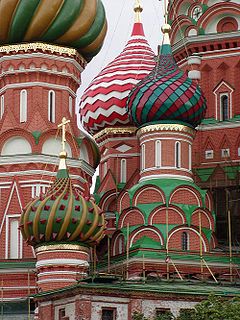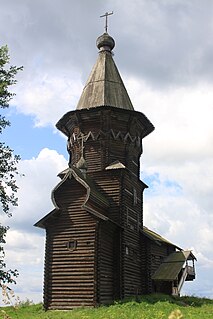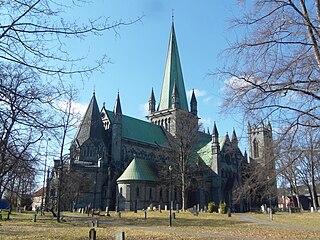
A spire is a tapering conical or pyramidal structure on the top of a building, often a skyscraper or a church tower, similar to a steep tented roof. Etymologically, the word is derived from the Old English word spir, meaning a sprout, shoot, or stalk of grass.

Kolomenskoye is a former royal estate situated several kilometers to the southeast of the city center of Moscow, Russia, on the ancient road leading to the town of Kolomna. The 390 hectare scenic area overlooks the steep banks of the Moskva River. It became a part of Moscow in the 1960s.

Kizhi is an island near the geometrical center of the Lake Onega in the Republic of Karelia, Russia. It is elongated from north to south and is about 6 km long, 1 km wide and is about 68 km away from the capital of Karelia, Petrozavodsk.

Menshikov Tower, also known as the Church of Archangel Gabriel, is a Baroque Russian Orthodox Church in Basmanny District of Moscow, within the Boulevard Ring. The church was initially built in 1707 to order of Alexander Menshikov by Ivan Zarudny assisted by Domenico Trezzini, a team of Italian-Swiss craftsmen from Ticino and Fribourg cantons and Russian stonemasons from Kostroma and Yaroslavl. The earliest extant Petrine Baroque building in Moscow, Menshikov Tower was substantially altered in the 1770s. The church traditionally functioned in summer only; in winter the congregation assembled in nearby Church of Theodor Stratelates, built in 1782–1806. Church of Saint Theodore also provides the bells for ritual ringing: despite its height, Menshikov Tower does not have bells.

Naryshkin Baroque, also referred to as Moscow Baroque or Muscovite Baroque, is the name of the particular style of Baroque architecture and decoration that was fashionable in Moscow from the late 17th century into the early 18th century. In the late 17th century, the Western European Baroque style of architecture combined with traditional Russian architecture to form a unique style, that is now known as Muscovite or Naryshkin Baroque. This style is called Muscovite Baroque as it was originally only found within Moscow and the surrounding areas. It is more commonly referred to as Naryshkin Baroque, as the first church designed in this style was built on one of the Naryshkin family's estates.

An onion dome is a dome whose shape resembles an onion and is usually associated with Russian architectural style. Such domes are often larger in diameter than the tholobate upon which they sit, and their height usually exceeds their width. These bulbous structures taper smoothly to a point.

A tented roof is a type of polygonal hipped roof with steeply pitched slopes rising to a peak. Tented roofs, a hallmark of medieval religious architecture, were widely used to cover churches with steep, conical roof structures.

Kizhi Pogost is a historical site dating from the 17th century on Kizhi island. The island is located on Lake Onega in the Republic of Karelia, Russia. The pogost is the area inside a fence which includes two large wooden churches and a bell-tower. The pogost is famous for its beauty and longevity, despite that it is built exclusively of wood. In 1990, it was included in the UNESCO list of World Heritage sites and in 1993 listed as a Russian Cultural Heritage site.

Red Gate were triumphal arches built in an exuberantly baroque design in Moscow. Gates and arches of this type were common back in 18th century Moscow. However, the Red Gate was the only one that survived until the 20th century. It was demolished in 1928 and the name still survives in an eponymous Moscow Metro station.

Russian architecture follows a tradition whose roots lie in early Russian wooden architecture and in the architecture of Kievan Rus' with its centers in Veliky Novgorod and Kiev. Russian architecture was also influenced by the Byzantine Empire. While Russian or Rus' architecture and culture was in many cases inspired by the Byzantine Empire, the influence was also limited. A large part of Russian architecture developed independently and was characterized by national and local features. After the fall of Kiev, Russian architectural history continued in the principalities of Vladimir-Suzdal, Novgorod, the succeeding states of the Tsardom of Russia. The great churches of Kievan Rus', built after the adoption of Christianity in 988, were the first examples of monumental architecture in the East Slavic region. Early Eastern Orthodox churches were mainly built from wood, with their simplest form known as a cell church. Major cathedrals often featured many small domes, which has led some art historians to infer how the pagan Slavic temples may have appeared.

Goshavank is a 12th- or 13th-century Armenian monastery located in the village of Gosh in the Tavush Province of Armenia. The impressive monastery which has remained in relatively good condition also houses one of the world's finest examples of a khachkar.
Renaissance architecture was that style of architecture which evolved firstly in Florence and then Rome and other parts of Italy as the result of Renaissance humanism and a revived interest in Classical architecture. It was part of the general movement known as the Italian Renaissance, which spread outwards from Italy and effected many aspects of scholarship and the arts. When the Renaissance spirit was exported into Eastern Europe, it had to compromise with local traditions and climates. The Renaissance style differs from place to place throughout the region with many local characteristics making themselves apparent.

The Russian Revival style is the generic term for a number of different movements within Russian architecture that arose in second quarter of the 19th century and was an eclectic melding of pre-Petrine Russian architecture and elements of Byzantine architecture.

Carpathian Wooden Churches is the name of a UNESCO World Heritage Site that consists of nine wooden religious buildings constructed between the 16th and 18th centuries in eight different locations in Slovakia. They include two Roman Catholic, three Protestant and three Greek Catholic churches plus one belfry in Hronsek. In addition to these churches there are about 50 more wooden churches in the territory of present-day Slovakia mainly in the northern and eastern part of the Prešov Region.

Log buildings and structures can be categorized as historic and modern. A diverse selection of their forms and styles with examples of architectural elements is discussed in the following articles:

Russian churches often have various recurrent elements in their architectural style.The onion dome is for example a recurrent and important element in the architecture of Russian churches. Often Russian churches have also multi-colored filigree ornamental elements in their architecture. Furthermore the colour white plays an important role in the style of Russian churches. In the past architecture for Russian churches often was made out of wood. Many Russian Orthodox churches are distinguished by their verticality, bright colors and multiple domes which provide a striking contrast with the flat Russian landscape often covered in snow. The very first churches in Kievan Rus', such as the 13-domed wooden St. Sophia Cathedral in Novgorod, differed in this regard from their mainly single-cupola Byzantine predecessors. The number of domes was important symbolically. One dome symbolized the single God; three represented the Trinity and five represented Christ and his four evangelists. At first the baptistery, narthex, and choir gallery above the narthex were a common feature of Rus' churches, but gradually they disappeared. After a century of Byzantine imitations, the Russian masons began to emphasise the verticality in church design.

Dormition Church of Kondopoga was a Russian Orthodox Church in the city of Kondopoga, Kondopozhsky District of the Republic of Karelia. The church was located in the historic part of the city, in the former village of Kondopoga, on the shores of Lake Onega Kondopozhskaya Bay on a promontory jutting into Chupa Bay. Elevation Church was 42 meters. The height of the tent and log towers, two octagons and the quadrangle, and the quadrangular height and width was in the ratio of about 1:2.

Church building in Norway began when Christianity was established there around the year 1000. The first buildings may have been post churches erected in the 10th or 11th century, but the evidence is inconclusive. For instance under Urnes Stave Church and Lom Stave Church there are traces of older post churches. Post churches were later replaced by the more durable stave churches. About 1,300 churches were built during the 12th and 13th centuries in what was Norway's first building boom. A total of about 3,000 churches have been built in Norway, although nearly half of them have perished. From 1620 systematic records and accounts were kept although sources prior to 1620 are fragmented. Evidence about early and medieval churches is partly archaeological. The "long church" is the most common type of church in Norway. There are about 1620 buildings recognized as churches affiliated with the Church of Norway. In addition, there are a number of gospel halls belonging to the lay movement affiliated with the Church of Norway as well as churches belonging to other Christian bodies. Until the 20th century, most churches were built from wood. 220 buildings are protected by law, and an additional 765 are listed as valuable cultural heritage.

Siberian Baroque is an architectural style common for ambitious structures in 18th-century Siberia, where 115 stone churches in Siberia were recorded in 1803, most of which were built in this provincial variant of the Russian Baroque, influenced by the Ukrainian Baroque and in some cases even incorporating lamaist motifs. Most of the buildings were preserved in Irkutsk, Tobolsk and Tomsk. An original interior of a Siberian Baroque structure survives only in the Feast of the Cross Church in Irkutsk.



















